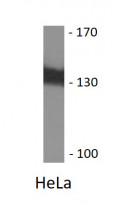ARG40343
anti-INCENP antibody
anti-INCENP antibody for Western blot and Human,Rat
Overview
| Product Description | Rabbit Polyclonal antibody recognizes INCENP |
|---|---|
| Tested Reactivity | Hu, Rat |
| Tested Application | WB |
| Host | Rabbit |
| Clonality | Polyclonal |
| Isotype | IgG |
| Target Name | INCENP |
| Antigen Species | Human |
| Immunogen | Recombinant fusion protein corresponding to aa. 785-914 of Human INCENP (NP_064623.2). |
| Conjugation | Un-conjugated |
| Alternate Names | Inner centromere protein |
Application Instructions
| Application Suggestion |
|
||||
|---|---|---|---|---|---|
| Application Note | * The dilutions indicate recommended starting dilutions and the optimal dilutions or concentrations should be determined by the scientist. | ||||
| Positive Control | HeLa | ||||
| Observed Size | 135 kDa |
Properties
| Form | Liquid |
|---|---|
| Purification | Affinity purified. |
| Buffer | PBS (pH 7.3), 0.02% Sodium azide and 50% Glycerol. |
| Preservative | 0.02% Sodium azide |
| Stabilizer | 50% Glycerol |
| Storage Instruction | For continuous use, store undiluted antibody at 2-8°C for up to a week. For long-term storage, aliquot and store at -20°C. Storage in frost free freezers is not recommended. Avoid repeated freeze/thaw cycles. Suggest spin the vial prior to opening. The antibody solution should be gently mixed before use. |
| Note | For laboratory research only, not for drug, diagnostic or other use. |
Bioinformation
| Database Links | |
|---|---|
| Gene Symbol | INCENP |
| Gene Full Name | inner centromere protein antigens 135/155kDa |
| Background | In mammalian cells, 2 broad groups of centromere-interacting proteins have been described: constitutively binding centromere proteins and 'passenger,' or transiently interacting, proteins (reviewed by Choo, 1997). The constitutive proteins include CENPA (centromere protein A; MIM 117139), CENPB (MIM 117140), CENPC1 (MIM 117141), and CENPD (MIM 117142). The term 'passenger proteins' encompasses a broad collection of proteins that localize to the centromere during specific stages of the cell cycle (Earnshaw and Mackay, 1994 [PubMed 8088460]). These include CENPE (MIM 117143); MCAK (MIM 604538); KID (MIM 603213); cytoplasmic dynein (e.g., MIM 600112); CliPs (e.g., MIM 179838); and CENPF/mitosin (MIM 600236). The inner centromere proteins (INCENPs) (Earnshaw and Cooke, 1991 [PubMed 1860899]), the initial members of the passenger protein group, display a broad localization along chromosomes in the early stages of mitosis but gradually become concentrated at centromeres as the cell cycle progresses into mid-metaphase. During telophase, the proteins are located within the midbody in the intercellular bridge, where they are discarded after cytokinesis (Cutts et al., 1999 [PubMed 10369859]).[supplied by OMIM, Mar 2008] |
| Function | Component of the chromosomal passenger complex (CPC), a complex that acts as a key regulator of mitosis. The CPC complex has essential functions at the centromere in ensuring correct chromosome alignment and segregation and is required for chromatin-induced microtubule stabilization and spindle assembly. Probably acts through association with AURKB or AURKC. Seems to bind directly to microtubules. Controls the kinetochore localization of BUB1. [UniProt] |
| Cellular Localization | Nucleus. Chromosome, centromere. Cytoplasm, cytoskeleton, spindle. Midbody. Chromosome, centromere, kinetochore. Note=Colocalized at synaptonemal complex central element from zygotene up to late pachytene when it begins to relocalize to heterochromatic chromocenters. Colocalizes with AURKB at a connecting strand traversing the centromere region and joining sister kinetochores, in metaphase II centromeres. [UniProt] |
| Calculated MW | 105 kDa |
| PTM | Phosphorylation by AURKB or AURKC at its C-terminal part is important for AURKB or AURKC activation by INCENP. [UniProt] |
Images (1) Click the Picture to Zoom In






